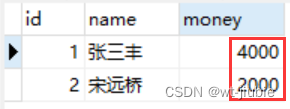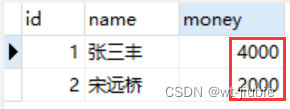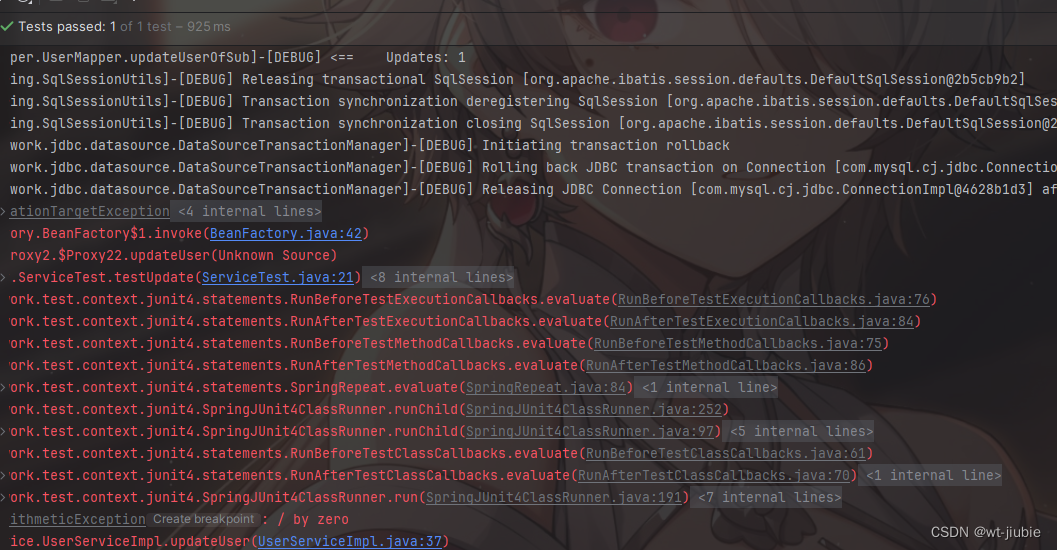Spring——Spring的事务控制(2)升级篇
发布时间:2024年01月08日
1.改造转账案例
1.1.applicationContext.xml
<!--配置事物管理器-->
<bean class="org.springframework.jdbc.datasource.DataSourceTransactionManager">
<property name="dataSource" ref="dataSource"/>
</bean>
<!--配置事物属性-->
<bean class="org.springframework.transaction.support.DefaultTransactionDefinition">
<property name="propagationBehaviorName" value="PROPAGATION_REQUIRED"/>
<property name="readOnly" value="false"></property>
</bean>
1.2.service
@Service
public class UserServiceImpl implements UserService {
@Autowired
private UserMapper userMapper;
@Autowired
private TransactionDefinition txDefinition;
@Autowired
private PlatformTransactionManager txManager;
/**
* 转账
* @param source
* @param target
* @param money
*/
@Override
public void updateUser(String source, String target, Float money) {
// 获取一个事务
TransactionStatus txStatus = txManager.getTransaction(txDefinition);
try {
userMapper.updateUserOfSub(source, money);
int a = 6/0;
userMapper.updateUserOfAdd(target, money);
//提交事务
txManager.commit(txStatus);
}catch (Exception e){
//回滚事务
txManager.rollback(txStatus);
e.printStackTrace();
}
}
}
1.3.测试
@RunWith(SpringJUnit4ClassRunner.class)
@ContextConfiguration("classpath:applicationContext.xml")//加载配置文件
public class ServiceTest {
@Autowired
private UserService userService;
/**
* 转账业务
*/
@Test
public void testUpdate(){
userService.updateUser("张三丰","宋远桥",1F);
}
}
-
事务回滚:

-
满足执行:

-
我们现在虽然实现了事务控制,但是代码非常的臃肿,我们可以使用动态代理简化代码
2.动态代理控制事务
2.1.factory
我们创建一个工厂,专门用来给 Service 创建代理对象,如下:
package com.wt.factory;
import com.wt.service.UserService;
import com.wt.service.UserServiceImpl;
import org.hamcrest.Factory;
import org.springframework.beans.factory.annotation.Autowired;
import org.springframework.stereotype.Component;
import org.springframework.transaction.PlatformTransactionManager;
import org.springframework.transaction.TransactionDefinition;
import org.springframework.transaction.TransactionStatus;
import java.lang.reflect.InvocationHandler;
import java.lang.reflect.Method;
import java.lang.reflect.Proxy;
/**
* bean工厂
*/
@Component
public class BeanFactory {
@Autowired
private UserService userService;
@Autowired
private TransactionDefinition txDefinition;
@Autowired
private PlatformTransactionManager txManager;
/**
* 获得UserServiceImpl对象
*
* @return
*/
public UserService getUserService() {
return (UserService) Proxy.newProxyInstance(
userService.getClass().getClassLoader(),
userService.getClass().getInterfaces(),
new InvocationHandler() {
public Object invoke(Object proxy, Method method, Object[] args)
throws Throwable {
//开启事务
TransactionStatus txStatus =
txManager.getTransaction(txDefinition);
try {
method.invoke(userService, args);
//提交事务
txManager.commit(txStatus);
} catch (Exception e) {
//回滚事务
txManager.rollback(txStatus);
e.printStackTrace();
}
return null;
}
});
}
}
2.2.applicationContext.xml
<!--配置service代理对象-->
<bean id="proxyService" factory-bean="beanFactory" factory-method="getUserService"></bean>
2.3.service
@Service
public class UserServiceImpl implements UserService {
@Autowired
private UserMapper userMapper;
/**
* 转账
* @param source
* @param target
* @param money
*/
@Override
public void updateUser(String source, String target, Float money) {
userMapper.updateUserOfSub(source, money);
int a = 6/0;
userMapper.updateUserOfAdd(target, money);
}
}
2.4.测试
@RunWith(SpringJUnit4ClassRunner.class)
@ContextConfiguration("classpath:applicationContext.xml")
public class ServiceTest {
@Autowired
@Qualifier("proxyService")//注入代理对象
private UserService userService;
@Test
public void testUpdate(){
userService.updateUser("张三丰","宋远桥",1F);
}
}
- 事务回滚:

3.Spring AOP控制事务
3.1.导入schema约束
<?xml version="1.0" encoding="UTF-8"?>
<beans xmlns="http://www.springframework.org/schema/beans"
xmlns:context="http://www.springframework.org/schema/context"
xmlns:xsi="http://www.w3.org/2001/XMLSchema-instance"
xmlns:tx="http://www.springframework.org/schema/tx"
xmlns:aop="http://www.springframework.org/schema/aop"
xsi:schemaLocation="http://www.springframework.org/schema/beans
http://www.springframework.org/schema/beans/spring-beans.xsd
http://www.springframework.org/schema/context
http://www.springframework.org/schema/context/spring-context.xsd
http://www.springframework.org/schema/tx
http://www.springframework.org/schema/tx/spring-tx.xsd
http://www.springframework.org/schema/aop
https://www.springframework.org/schema/aop/spring-aop.xsd">
<!--配置事物属性
<bean class="org.springframework.transaction.support.DefaultTransactionDefinition">
<property name="propagationBehaviorName" value="PROPAGATION_REQUIRED"/>
<property name="readOnly" value="false"></property>
</bean>
配置service代理对象
<bean id="proxyService" factory-bean="beanFactory" factory-method="getUserService">
</bean>-->
</beans>
3.2.配置增强
<!-- 1、增强 -->
<tx:advice id="txAdvice" transaction-manager="transactionManager">
<!--事务属性-->
<tx:attributes>
<!-- 指定方法名称:是业务核心方法
read-only:是否是只读事务。默认false,不只读。
isolation:指定事务的隔离级别。默认值是使用数据库的默认隔离级别。
propagation:指定事务的传播行为。
timeout:指定超时时间。默认值为:-1。永不超时。
rollback-for:用于指定一个异常,当执行产生该异常时,事务回滚。产生其他异常,事务不回滚。
省略时任何异常都回滚。
-->
<tx:method name="*" read-only="false" propagation="REQUIRED"/>
<tx:method name="select*" read-only="true" propagation="SUPPORTS"/>
<tx:method name="get*" read-only="true" propagation="SUPPORTS"/>
</tx:attributes>
</tx:advice>
3.3.配置切点
<aop:config>
<!--2、切点-->
<aop:pointcut expression="execution(* com.wt.service.*.*(..))" id="pointcut"/>
</aop:config>
3.4.配置切面
<aop:config>
<!--3、切面-->
<aop:advisor advice-ref="txAdvice" pointcut-ref="pointcut"></aop:advisor>
</aop:config>
3.5.factory
删除bean工程
3.6.测试
@RunWith(SpringJUnit4ClassRunner.class)
@ContextConfiguration("classpath:applicationContext.xml")//加载配置文件
public class ServiceTest {
@Autowired
private UserService userService;
/**
* 转账业务
*/
@Test
public void testUpdate(){
userService.updateUser("张三丰","宋远桥",1F);
}
}
-
事务回滚:

-
问题一:如果我们把方法名称改了,那么事务还会回滚吗?
- 修改applicationContext.xml:

- 修改service:

-
问题二:如果我们把异常捕捉了,那么事务还会回滚吗?

文章来源:https://blog.csdn.net/wan_m_m/article/details/135466361
本文来自互联网用户投稿,该文观点仅代表作者本人,不代表本站立场。本站仅提供信息存储空间服务,不拥有所有权,不承担相关法律责任。 如若内容造成侵权/违法违规/事实不符,请联系我的编程经验分享网邮箱:chenni525@qq.com进行投诉反馈,一经查实,立即删除!
本文来自互联网用户投稿,该文观点仅代表作者本人,不代表本站立场。本站仅提供信息存储空间服务,不拥有所有权,不承担相关法律责任。 如若内容造成侵权/违法违规/事实不符,请联系我的编程经验分享网邮箱:chenni525@qq.com进行投诉反馈,一经查实,立即删除!
最新文章
- Python教程
- 深入理解 MySQL 中的 HAVING 关键字和聚合函数
- Qt之QChar编码(1)
- MyBatis入门基础篇
- 用Python脚本实现FFmpeg批量转换
- 【漏洞复现】Hikvision综合安防管理平台files文件上传漏洞
- 【Python高阶技巧】正则表达式
- mysql原理--redo日志2
- 微软推出iOS 版Copilot App 让你免费用GPT-4
- 自己动手写编译器:语法解析的基本原理
- AI时代?——Python与open AI之间的联系
- HCIP实验5-mpls实验
- 图纸加密防泄密软件排名
- 做自动化测试框架,这些经验和技巧一定要牢记
- 2023年,我是如何戒掉AI焦虑症的